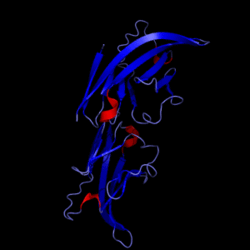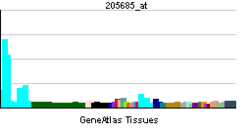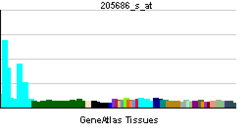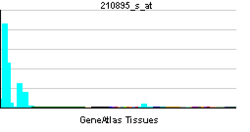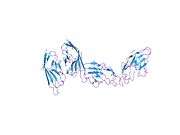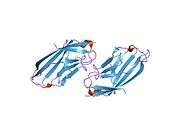CD86
| View/Edit Human | View/Edit Mouse |
Cluster of Differentiation 86 (also known as CD86 and B7-2) is a protein expressed on antigen-presenting cells that provides costimulatory signals necessary for T cell activation and survival. It is the ligand for two different proteins on the T cell surface: CD28 (for autoregulation and intercellular association) and CTLA-4 (for attenuation of regulation and cellular disassociation). CD86 works in tandem with CD80 to prime T cells.
The CD86 gene encodes a type I membrane protein that is a member of the immunoglobulin superfamily.[4] Alternative splicing results in two transcript variants encoding different isoforms. Additional transcript variants have been described, but their full-length sequences have not been determined.[5]
See also
- Cluster of differentiation
- CD80
- CD28
- CTLA-4
- List of human clusters of differentiation for a list of CD molecules
References
- ↑ "Diseases that are genetically associated with CD86 view/edit references on wikidata".
- ↑ "Human PubMed Reference:".
- ↑ "Mouse PubMed Reference:".
- ↑ Chen C, Gault A, Shen L, Nabavi N (May 1994). "Molecular cloning and expression of early T cell costimulatory molecule-1 and its characterization as B7-2 molecule". J. Immunol. 152 (10): 4929–36. PMID 7513726.
- ↑ "Entrez Gene: CD86 CD86 molecule".
Further reading
- Davila S, Froeling FE, Tan A, et al. (2010). "New genetic associations detected in a host response study to hepatitis B vaccine.". Genes Immun. 11 (3): 232–8. doi:10.1038/gene.2010.1. PMID 20237496.
- Csillag A, Boldogh I, Pazmandi K, et al. (2010). "Pollen-induced oxidative stress influences both innate and adaptive immune responses via altering dendritic cell functions.". J. Immunol. 184 (5): 2377–85. doi:10.4049/jimmunol.0803938. PMC 3028537
 . PMID 20118277.
. PMID 20118277. - Bossé Y, Lemire M, Poon AH, et al. (2009). "Asthma and genes encoding components of the vitamin D pathway". Respir. Res. 10: 98. doi:10.1186/1465-9921-10-98. PMC 2779188
 . PMID 19852851.
. PMID 19852851. - Mosbruger TL, Duggal P, Goedert JJ, et al. (2010). "Large-scale candidate gene analysis of spontaneous clearance of hepatitis C virus". J. Infect. Dis. 201 (9): 1371–80. doi:10.1086/651606. PMC 2853721
 . PMID 20331378.
. PMID 20331378. - Bugeon L, Dallman MJ (2000). "Costimulation of T cells". Am. J. Respir. Crit. Care Med. 162 (4 Pt 2): S164–8. doi:10.1164/ajrccm.162.supplement_3.15tac5. PMID 11029388.
- Pan XM, Gao LB, Liang WB, et al. (2010). "CD86 +1057 G/A polymorphism and the risk of colorectal cancer". DNA Cell Biol. 29 (7): 381–6. doi:10.1089/dna.2009.1003. PMID 20380573.
- Dalla-Costa R, Pincerati MR, Beltrame MH, et al. (2010). "Polymorphisms in the 2q33 and 3q21 chromosome regions including T-cell coreceptor and ligand genes may influence susceptibility to pemphigus foliaceus". Hum. Immunol. 71 (8): 809–17. doi:10.1016/j.humimm.2010.04.001. PMID 20433886.
- Talmud PJ, Drenos F, Shah S, et al. (2009). "Gene-centric association signals for lipids and apolipoproteins identified via the HumanCVD BeadChip". Am. J. Hum. Genet. 85 (5): 628–42. doi:10.1016/j.ajhg.2009.10.014. PMC 2775832
 . PMID 19913121.
. PMID 19913121. - Carreño LJ, Pacheco R, Gutierrez MA, et al. (2009). "Disease activity in systemic lupus erythematosus is associated with an altered expression of low-affinity Fc gamma receptors and costimulatory molecules on dendritic cells". Immunology. 128 (3): 334–41. doi:10.1111/j.1365-2567.2009.03138.x. PMC 2770681
 . PMID 20067533.
. PMID 20067533. - Koyasu S (2003). "The role of PI3K in immune cells". Nat. Immunol. 4 (4): 313–9. doi:10.1038/ni0403-313. PMID 12660731.
- Kim SH, Lee JE, Kim SH, et al. (2009). "Allelic variants of CD40 and CD40L genes interact to promote antibiotic-induced cutaneous allergic reactions". Clin. Exp. Allergy. 39 (12): 1852–6. doi:10.1111/j.1365-2222.2009.03336.x. PMID 19735272.
- Liu Y, Liang WB, Gao LB, et al. (2010). "CTLA4 and CD86 gene polymorphisms and susceptibility to chronic obstructive pulmonary disease". Hum. Immunol. 71 (11): 1141–6. doi:10.1016/j.humimm.2010.08.007. PMID 20732370.
- Ma XN, Wang X, Yan YY, et al. (2010). "Absence of association between CD86 +1057G/A polymorphism and coronary artery disease". DNA Cell Biol. 29 (6): 325–8. doi:10.1089/dna.2009.0987. PMID 20230296.
- Ishizaki Y, Yukaya N, Kusuhara K, et al. (2010). "PD1 as a common candidate susceptibility gene of subacute sclerosing panencephalitis". Human Genetics. 127 (4): HASH(0x31b6c40). doi:10.1007/s00439-009-0781-z. PMID 20066438.
- Chang TT, Kuchroo VK, Sharpe AH (2002). "Role of the B7-CD28/CTLA-4 pathway in autoimmune disease". Curr. Dir. Autoimmun. 5: 113–30. doi:10.1159/000060550. PMID 11826754.
- Grujic M, Bartholdy C, Remy M, et al. (2010). "The role of CD80/CD86 in generation and maintenance of functional virus-specific CD8+ T cells in mice infected with lymphocytic choriomeningitis virus". J. Immunol. 185 (3): 1730–43. doi:10.4049/jimmunol.0903894. PMID 20601595.
- Quaranta MG, Mattioli B, Giordani L, Viora M (2006). "The immunoregulatory effects of HIV-1 Nef on dendritic cells and the pathogenesis of AIDS". FASEB J. 20 (13): 2198–208. doi:10.1096/fj.06-6260rev. PMID 17077296.
- Schuurhof A, Bont L, Siezen CL, et al. (2010). "Interleukin-9 polymorphism in infants with respiratory syncytial virus infection: an opposite effect in boys and girls". Pediatr. Pulmonol. 45 (6): 608–13. doi:10.1002/ppul.21229. PMID 20503287.
- Bailey SD, Xie C, Do R, et al. (2010). "Variation at the NFATC2 locus increases the risk of thiazolidinedione-induced edema in the Diabetes REduction Assessment with ramipril and rosiglitazone Medication (DREAM) study". Diabetes Care. 33 (10): 2250–3. doi:10.2337/dc10-0452. PMC 2945168
 . PMID 20628086.
. PMID 20628086. - Radziewicz H, Ibegbu CC, Hon H, et al. (2010). "Transient CD86 expression on hepatitis C virus-specific CD8+ T cells in acute infection is linked to sufficient IL-2 signaling". J. Immunol. 184 (5): 2410–22. doi:10.4049/jimmunol.0902994. PMC 2924663
 . PMID 20100932.
. PMID 20100932.
This article incorporates text from the United States National Library of Medicine, which is in the public domain.
